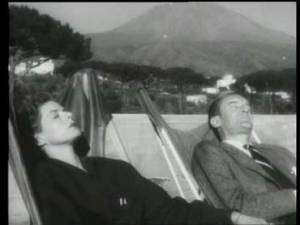Journey to Italy
May 21, 2013 § 1 Comment
When asked by Eric Rohmer and François Truffaut about Journey to Italy in a Cahiers du Cinéma interview, Roberto Rossellini described the importance of Naples: “… that strange atmosphere which is mingled with the very real, very immediate, very deep feeling, the sense of eternal life.”
The city of Naples, its bay, its islands, its volcano and the site of Pompeii are not merely the setting for the film, they are its pulse, the vitality of its human figures and the potent endurance of its ancient places quickening the slow-paced drama of an English couple who have driven to Italy to sell a recently inherited villa. As plot, Journey to Italy meanders, yet, watching, I found shot after beautiful shot elusive, tantalising, and I wanted to stop the couple’s Rolls-Royce and enter the flow of the busy Naples streets, where Ingrid Bergman’s character is disturbed by the presence of so many children, so many pregnant women; I wanted to dwell on the shape of Vesuvius in the landscape spread out in front of her as she languorously voices her discontent. The energy of its documentary passages, of the Neapolitan music and rhythms of speech all counterpoint the inertia of the relationship between the film’s protagonists; even the statues in the archaeological museum are given more life by the circling camera than Bergman, immobilised and clearly dumbfounded by what they make her feel. Both she and George Sanders are as much at odds with where they are as they are with one another, and they sometimes appear offended by its beauty, not just by any perception of vulgar excess, but because it kindles emotions that trouble and confuse.
Rossellini’s “eternal life” can easily be understood in a Christian sense, given the film’s proliferation of Christian signs and symbols: the funeral procession, the catacombs and those praying there, the miracle seekers in the crowded final scene. But Naples is Italy’s oldest city, and the mysteries of the mythic ancient world linger in its topography and natural forces; within its long history the material cycles of life and death stretch further back than we can imagine. The volcano embodies both: our planet’s firework explosion into fertile being, as well as a threat of destruction. Intimations of birth and death run through the film and by its end Bergman’s character has fully understood the truism that “life is short”.
This is no simple tale of spiritual renewal, or the loosening of English inhibitions. The film’s progress is mysterious, made visible yet unexplained, simultaneously essayistic and alive with stories barely told. There’s a cumulative intensity in what surrounds its two main characters, most of all in what touches the woman in this couple, for she listens and sees more than her husband. Made in 1953, it was quite unlike the cinema of its day. Besides all else, it’s a homage to James Joyce. Joyce is the couple’s surname, and at one key moment Bergman tells Sanders about a young poet she knew before meeting him, the memory and its melancholy narration an echo of Joyce’s short story, The Dead. And on these Homeric shores allusions to Ulysses multiply, even playfully in the name of the inherited villa’s dead owner: uncle Homer.
I first came across Journey to Italy in the 1970s, but only on paper, when I was translating some of the articles from Cahiers du Cinéma for publication in an anthology. Alas, there was no chance to see it – before DVDs, or available videocassettes. About 15 years ago I saw it in Italy, but Bergman and Sanders were dubbed into Italian, robbing them of their voices, their verbal nuances, the stiffness of their upper-class tones, and the print was fuzzy. Last week I finally watched it in all its poetic glory, in a print restored by the Bologna Cineteca. It’s currently showing at the BFI and other London cinemas, and doubtless outside London too.
The Cahiers critics were bowled over by this film when it appeared. Eric Rohmer, profoundly Catholic, hailed it as a new form of sacred art: “… the cinema is taking over from the cathedrals!” But Jacques Rivette’s assessment, in a long thoughtful essay on Rossellini, has certainly been vindicated: “… if there is a modern cinema, this is it.”
He went on to say: “Here is our cinema, those of us who in our turn are preparing to make films…” . It was, and they were the New Wave.

